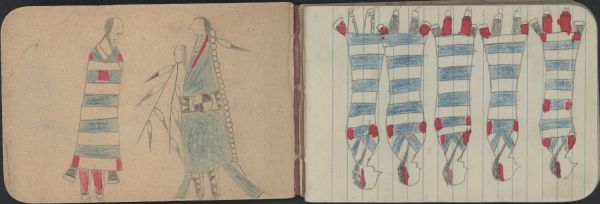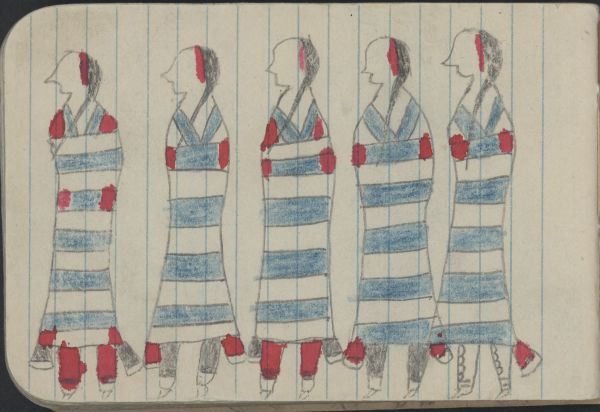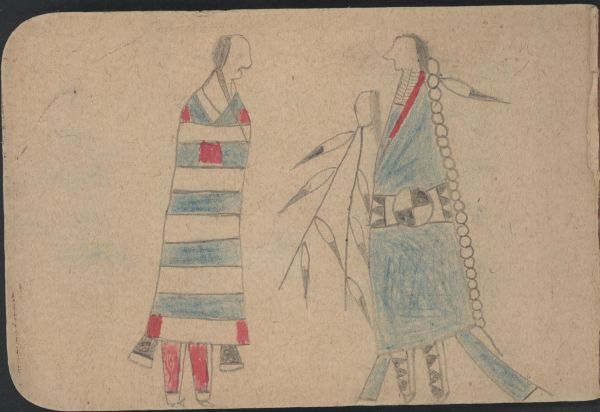COURTING: Man in Blue Blanket with Beaded Strip Faces Woman in 2nd Phase Chief's Blanket; GROUP, WOMEN: Five Women in 2nd Phase Chief's Blankets
Ethnographic Notes
This plate begins with two opposite sequences in the KSHS Northern Cheyenne ledger notebook. It appears to have been started at one end, then rotated and continued from the other end, so the two parts of the book align oppositely. This continues through the volume. The following descriptions will read right to left, the direction of action in the syntax of Cheyenne ledgers. Candace Greene first noted this syntactical directionality; action and/or power moves from the right-hand side of the drawing (viewer�s perspective) to the left ("Structure" 26; also Peterson 273). INSIDE COVER COURTING: COUPLE. Man and woman dressed for formal courtship face each other. The man wears a Lakota-style courting blanket made of blue Stroud cloth lengths joined by a beaded strip with a medicine wheel design (see William Powers 1980: 40-47 for discussion of courtship blanket designs and their Lakota connections; and Petersen, 1983: 282). The Cheyenne suitor wears a German silver hairplate ornament tied onto his scalp lock; a single eagle feather with black tip is attached to the second hairplate. He also wears a hairpipe breastplate, and he has red cloth wrapped around his braids. A saber handle is visible in his right hand, with seven immature golden eagle feathers attached. Bonnie Kahn describes 1860 cavalry sabers in ledger art in "The Pamplin Ledger: Civilian, Indian, and Military Equipment" (2003: 97-9). His long breechcloth ends are visible beneath the blanket; they are made of blue trade cloth. His leggings have a beaded design referred to by Powell as the �Sacred Mountain� design (Sacred Mountain: 564), or lightening. This beadwork legging design occurs often in this ledger. His feet are greatly abbreviated. The woman wears a second-phase Navajo Chief�s blanket and red leggings. It is folded to show red at the shoulders, chest, and lower outer edges. Such colorful blankets were available through trade, and they were expensive. Dress panels or tabs show beneath the woman's blanket�inserts into the two halves of the dress (Petersen 1983: 287). One band is drawn around each ankle. This is similar to the black line "trails" drawn around the ankles of the honored "Sacred Woman" of the Sun Dance (Powell, 1969: 642). George Dorsey describes black lines as the representation of the four directional powers: "The first, or medicine-spirit of the south, was represented by a black circular line encompassing the right ankle; the west spirit by a line around the right wrist; the north spirit by a line around the left wrist; and the east spirit by a line around the right ankle" (1905: vol. 2, 105). One to four bands drawn on women's ankles occur throughout the ledger. Courtship is the subject matter for seventeen of this ledger's drawings (plates 1, 8-12, 19, 21-25, 33-36, 42). The conventions of courtship blanket, "skunk" blanket, and right-to-left positioning (pursuing male to the right of the female) all recur. Media: Pencil outlines and details; blue crayon fill; red crayon
p. 1. COURTSHIP: WOMEN. Five women wear identical blue-and-white striped blankets with red (second-phase Navajo chief blankets). Two wear red leggings, two have leggings penciled gray, and one has uncolored leggings with a vertical row of ornaments, perhaps brass buttons (see Benson Lanford, 2003: 164). Their heads are in profile, showing red-paint outlines along the vertical left hairline. The red markings on the blankets show subtle variations--two have red showing at the top stripe around the shoulders, four have red markings in the second stripe, one has red on the third stripe. All have bands drawn around their ankles, and all have ornamental ends of dress panels showing below their blankets�two gray and three red. This is the first of many similar depictions of nearly identical rows of women or men or both lined up. The notebooks were very small, so perhaps these do represent a formal occasion, like a dance. Other depictions of dance in Cheyenne ledger art show rows of participants and rows of spectators. Or this may simply illustrate the shift from action scenes of pre-reservation times to portraits of individuals or groups, with few personal details but regalia that suggests identity. Media: Pencil outlines, details, fill; blue crayon fill; red watercolor


